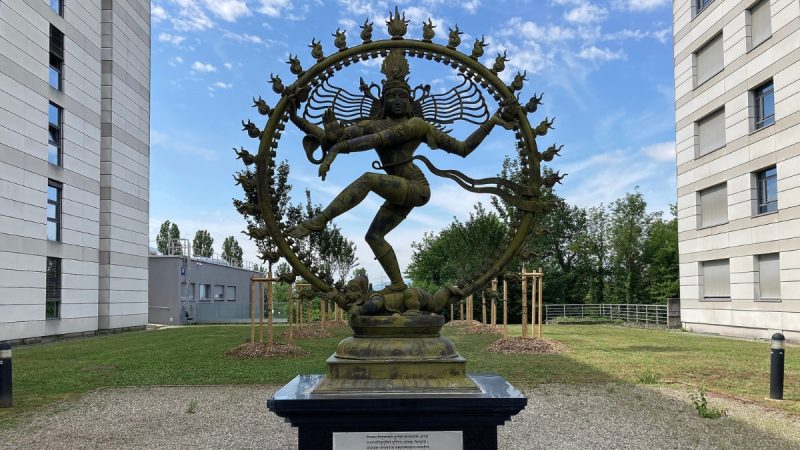When you think of Geneva’s CERN, the world’s most famous physics lab, what comes to mind? There would probably be a tonne of tunnels, massive machinery, and scientists trying to solve the mysteries of the cosmos. But if you ever visit CERN, you will find something completely different: a beautiful statue of Lord Shiva dressed as the cosmic dancer Nataraj. Yes, a piece of India is located in the centre of the most cutting-edge research facility in the world.
CERN In Geneva Is Home To A 2-Metre Lord Shiva Nataraj Statue Gifted By India
On 18 June 2004, CERN unveiled this 2-meter-tall bronze statue of Lord Shiva. It wasn’t just decoration, it was a gift from the Government of India to celebrate the long relationship between India and CERN, which began way back in the 1960s. Since then, the Nataraj statue has stood proudly between CERN’s Buildings 39 and 40, quietly becoming one of the most photographed and talked-about landmarks on campus.
In Hinduism, Lord Shiva has many forms, but Nataraj, Shiva as the Lord of Dance, is one of the most powerful. The Ananda Tandava, or dance of bliss, is a dance that symbolises the creation, preservation, and destruction that make up the rhythm of the universe.
Every detail of the statue has meaning:
- Shiva holds a damaru (drum) in one hand, symbolising creation and the universe’s first sound.
- He is holding fire in the other hand, which stands for destruction and change.
- One hand is raised in abhaya mudra, a gesture of protection and fearlessness.
- He dances inside a ring of flames, showing the eternal cycle of energy.
- There is a dwarf figure beneath his foot called Apasmara, who symbolises the destruction of ignorance by knowledge.
Now, why did India choose the Nataraj form of Shiva for CERN? Because physicists frequently use the same description of the universe: it is full of cycles of creation and destruction, with energy always in motion. Just like Shiva’s dance, the subatomic world is always moving.
Also Read: What Happens When Climate Change Targets Your Breakfast? Corn Flakes And Tofu May Be Next
When Science Met Spirituality
The idea of linking Shiva’s dance to modern physics isn’t new. Physicist Fritjof Capra, in his famous book The Tao of Physics, beautifully compared the dance of Nataraj with the dance of subatomic particles. His words are even inscribed on a plaque beside the statue: “For the modern physicists, then, Shiva’s dance is the dance of subatomic matter.”
For the scientists at CERN, who literally study the tiniest building blocks of matter and their constant motion, this connection makes the statue almost a poetic reflection of their work. People have always tried to understand the universe, sometimes through science, sometimes through spirituality, and sometimes through both, and the Nataraj statue at CERN shows just that.
Cover Image Courtesy: Wikimedia Commons/Peacearth

